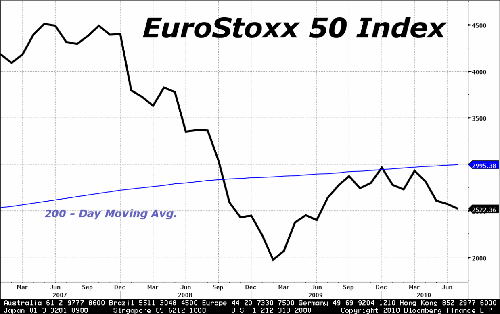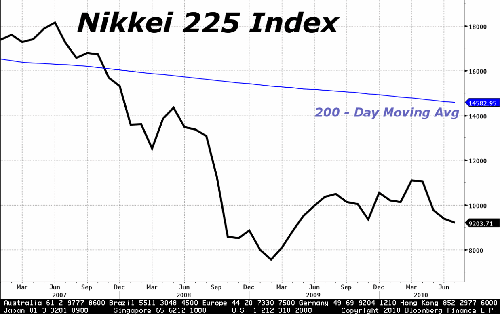Stocks Bear Market Rally Over
Stock-Markets / Stocks Bear Market Jul 07, 2010 - 09:23 AM GMTBy: Claus_Vogt
 The stock market’s rise since the March 2009 lows was nothing more than a bear market rally. Yes, it was a huge rally, but not out of the realm of similar historical examples.
The stock market’s rise since the March 2009 lows was nothing more than a bear market rally. Yes, it was a huge rally, but not out of the realm of similar historical examples.
Low trading volume, still high valuations and lingering economic problems — especially within the real estate sector and the banking system — have been strong arguments for my outlook. And the history of burst real estate bubbles could serve as a blueprint for our current dilemma.
I’ve never departed from that assessment of what was going on …
In fact, over the past months I’ve regularly predicted that the March lows would finally be broken and the stock market’s valuation would decline. What’s more, they would go all the way down to levels seen at historical secular lows and hit single digit price/earnings ratios.
Now it looks as if the bear market rally is over and the next cyclical bear market has begun. I say that because my cyclical stock market model has given me …
Five Bearish Signs
Sign #1— Valuations never fell Valuation metrics never fell to undervalued levels. But they quickly rose to overvalued again, as soon as the stock market recouped a good part of its losses.
Sign #2— Money dried up The liquidity indicators turned outright bearish. Not just in the U.S., but globally, too. These indicators are especially important during this cycle, because the rally since March 2009 was mainly liquidity driven.
It was simply a reaction to monetary and fiscal stimulus never heard of before, aside from during war times. And with liquidity drying up the uptrend was on rented time.
Sign #3— Excessive optimism Sentiment indicators reached levels indicating high complacency and even extreme optimism. Some put/call ratios fell as low as during the heights of the 2000 stock market bubble.
And the cash level of mutual funds fell to a record low. Lower than in March 2000, and lower than during the summer of 2007, the two former record lows. Both marked excellent times to get out of the stock market.
Sign #4— LEI fell
The Economic Cycle Research Institute’s Leading Economic Index fell below the zero line in early June. This leading economic indicator (LEI) for the U.S. economy came in at minus 7.7 percent. If history is our guide, this reading is a clear recession warning.
Until recently the only component for my model that wasn’t bearish was the technical situation of the stock market. Typically, important turning points are accompanied by negative divergences in market breadth indicators, such as the advance/decline line or the number of stocks making 52-week highs.
But that changed last week when …
Sign #5— The technical picture turned the corner
The technical component of my cyclical stock market model turned bearish on June 30. Have a look at the S&P 500 chart below to see what I’m talking about.

Source: Bloomberg
The market’s behavior since October 2009 looks like a well formed topping formation. Its lower boundary or neckline is the 1,040-1,050 area. The shape of the formation is a head and shoulders top, with the right shoulder having formed in June, accompanied by low volume, as it should be.
Then last Wednesday, the S&P 500 broke below this neckline. In doing so the topping pattern was finished with a clear technical sell signal.
This sell signal gets additional strength from the much oversold condition the market was in before last week’s breakdown took place, which is a sign of remarkable weakness. Normally a market as oversold as this one at least experiences a short-term bounce.
But that’s not all …
There is another strong technical argument signaling the end of the bear market rally and the beginning of a new cyclical bear market.
The upward trend of 200-day moving average of the S&P 500 has started to level off, also shown in the above chart. This moving average is a slow moving trend-following indicator. It won’t help you pick market tops or bottoms. But you can use it as a good sign post to tell you whether the cyclical trend is up or down.
And the 200-day moving average is not only a good indicator of the S&P 500 and most other major U.S. indexes, but also for the EuroStoxx 50 and the Nikkei 225 as shown in the two charts below.

Source: Bloomberg

Source: Bloomberg
Indeed, this adds fuel to the overall bearish message.
It’s Time to Get Out of the Stock Market
The evidence that a new bear market has begun is compelling. And I believe this downturn can easily last until 2012 with prices going much lower than in 2008.
In my opinion, the prudent thing to do now is to consider selling.
Best wishes,
Claus
This investment news is brought to you by Money and Markets. Money and Markets is a free daily investment newsletter from Martin D. Weiss and Weiss Research analysts offering the latest investing news and financial insights for the stock market, including tips and advice on investing in gold, energy and oil. Dr. Weiss is a leader in the fields of investing, interest rates, financial safety and economic forecasting. To view archives or subscribe, visit http://www.moneyandmarkets.com.
© 2005-2022 http://www.MarketOracle.co.uk - The Market Oracle is a FREE Daily Financial Markets Analysis & Forecasting online publication.



